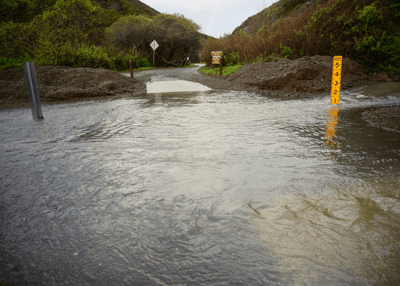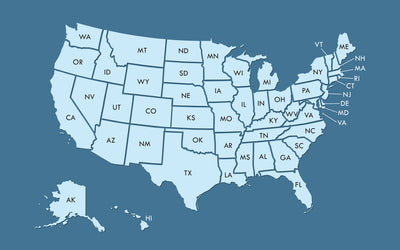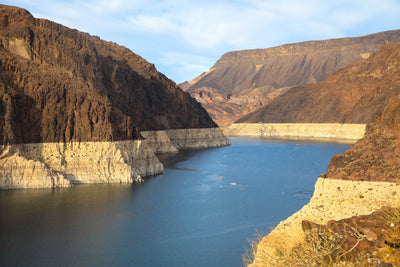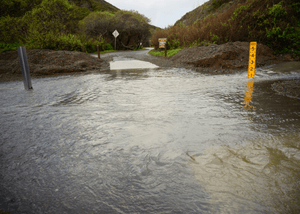Recent storms and atmospheric rivers can cause problems with drinking water infrastructure and both public & private water systems. Here's how you can protect yourself.
Water Quality InformationWritten By Actual Experts
RSSSevere Weather Can Impact Drinking Water Quality

Does My State Regulate PFAS Chemicals in Drinking Water?

States are responding to the nationwide PFAS crisis by implementing testing or removal requirements in municipal tap water. Per and Polyfluoroalkyl Substances (PFAS) have been detected in an increasingly alarming number of municipalities across the United States. Recent studies indicate that 200 million Americans drink tap water contaminated with PFAS chemicals. On April 10, 2024, the US EPA has announced drinking water standards to limit exposure to 5 types of PFAS chemicals.
How Do Droughts Affect Your Drinking Water?

Emily Driehaus | Science Communication Intern
**Updated 6/30/2022 to include latest updates
The ongoing drought in the western United States has severely depleted water supplies and left many states with water shortages. It's been going on for so long that it's now being called "aridification" in certain areas. Water restrictions have been implemented in parts of California and other western states. The lack of water can have an impact on both drinking water quality and water infrastructure.
Droughts and Water Supplies
The most apparent impact of a drought is the loss of water resources due to the lack of precipitation. An increase in temperature can also speed up the rate of evaporation of water from water supplies. This combination of factors can lead to drought conditions like what is currently being seen in the western U.S. Both natural bodies of water and human-made reservoirs are being depleted at alarming rates, leading to water shortages and restrictions.
How Can Droughts Impact Water Quality?
A U.S. Geological Survey study found that droughts may lead to elevated levels of naturally occurring arsenic in private wells and groundwater, and that the longer a drought lasts, the higher the probability of arsenic concentrations that exceed EPA’s standard for drinking water. Arsenic is naturally occuring in bedrock and sediments around the world and is commonly reported in private wells. Continued exposure to arsenic from drinking water is associated with an increased risk of several types of cancers and other adverse health effects.
A lack of rainfall can lead to reduced flow of rivers and streams, causing stagnation. Rainfall and other precipitation helps to keep rivers and streams flowing, but this stagnation from a reduced flow can lead to a buildup of pollutants. Microorganisms and viruses can contaminate stagnant water and can be transmitted through both drinking water and water used for watering crops. People who use private wells for drinking water are also more susceptible to these contaminants, as there is little flow during a drought. Additional water quality impacts during a drought include; turbidity, taste and odor, pathogen concerns, and challenges in managing disinfection byproducts (DBPs).
Impacts on Water Infrastructure:
The low water supply caused by droughts can have an impact on water systems, especially smaller systems. Poor water quality can affect a treatment facility’s ability to meet acceptable drinking water standards. This loss in water pressure can lead to boil-water advisories, which can add to the heat that often accompanies drought. Older pipes can also exacerbate water loss during a drought due to leaks.
Future Considerations
With climate change increasing the frequency and severity of droughts, the EPA is looking to help communities with drought resiliency. These efforts include installing water-efficient plumbing, such as low-flow toilets and showerheads that conserve water. Encouraging water reuse is also part of these efforts. For example, using water from a shower to water plants could be part of these efforts. In addition, many states have begun programs to encourage or require drought-tolerant plants and landscaping be installed in place of lawns. In fact, for each square foot of grass removed, homeowners save an average of 44 gallons of water a year. As climate change exacerbates the impacts of droughts, these water conservation efforts will become increasingly important.
How Do I Prepare for Water Shortages in a Drought?
According to the USGS, preparation before a drought should focus on water conservation. Replacing leaky plumbing and installing low-flow fixtures can conserve water in the long run, especially during a drought. During a drought, the Red Cross recommends not pouring water down the drain when it could be used for another purpose, such as watering plants. Conserving as much water as possible will allow for more water from faucets to be used for drinking during a drought.
Other Articles We Think You Might Enjoy:Plastic pipes are polluting drinking water systems after wildfires – it's a risk in urban fires, too
How Do Hurricanes Affect Your Drinking Water?
How Are Public and Private Water Systems Susceptible To Temporary Water Outages?
Drinking Water Issues in the East Bay Region of California

Christina Liu, B.S. | Hydroviv's Science Team
For Hydroviv’s assessment of East Bay MUD’s drinking water, we aggregated water quality test data from EBMUD, the U.S. Environmental Protection Agency (EPA), the Environmental Working Group, and the US Geological Survey. Our Water Nerds then cross referenced these data with toxicity studies in the scientific and medical literature, as well as upcoming regulatory changes. The custom water filters that we build for our customers in the East Bay Region of California are optimized with this research in mind.
Who Gets Drinking Water From The East Bay Municipal Utility District?
The East Bay Municipal Utility District (EBMUD) serves 1.4 Million customers in the East Bay Region of California, including the cities of Crockett, Rodeo, Hercules, Pinole, El Sobrante, San Pablo, Richmond, El Cerrito, Kensington, Orinda, Moraga, Piedmont, Oakland, Alameda, San Leandro, San Lorenzo, Castro Valley, Hayward, Albany, Berkeley, Emeryville, Lafayette, Pleasant Hill, Walnut Creek, Alamo, Danville, and San Ramon.
Source Water for EBMUD
The 577-square mile Mokelumne River watershed on the western slope of the Sierra Nevada is the major source of the water used by the East Bay customers. Snowmelt from Alpine, Amador, and Calaveras counties flows into Pardee Reservoir near Valley Springs. Three large aqueducts transport water 90 miles from Pardee Reservoir into EBMUD’s water distribution system.
Lead In East Bay’s Drinking Water
Lead enters into the consumer's tap water through old lead service pipes and lead-containing plumbing. When corrosion control measures fail (as witnessed in Flint, Michigan), lead leaches into the drinking water, reaching toxic levels. EBMUD conducted lead sampling of schools in their service area between 2017 and 2020. EBMUD reported results of less than 5 ppb in 95 percent of the samples and less than 1 ppb in 77 percent of the samples. Please bear in mind that EPA, CDC and the American Academy of Pediatrics all recognize that there is no safe level of lead for children. In addition, Federal regulations also cannot take into account levels measured at an individual tap.PFAS in East Bay’s Drinking Water
Per and Polyfluoroalkyl Substances (PFAS) are a category of emerging contaminants commonly used in firefighting foam, Teflon, non-stick surfaces, stain-resistant surfaces, and food packaging. The Agency for Toxic Substances and Disease Registry (ATSDR) has determined that PFAS exposure is associated with various adverse health effects, including an increased risk of cancer, lowered fertility rates, and developmental issues in infants and young children. A new study out of The Yale School of Public Health recently found that exposure to PFAS increases the risk of miscarriage by 80-120% in pregnant women. The Centers for Disease Control also issued a disclosure regarding a potential intersection between PFAS and COVID-19.
Even small amounts of PFAS are extremely toxic. PFAS are measured in parts per trillion, and one part per trillion is equivalent to one drop of water in 20 Olympic-sized swimming pools.
PFAS have been detected in a growing number of municipalities across the United States. Several years ago, the USEPA required large water systems (including EBMUD) to collect and analyze samples for a limited set of PFAS, and the CA State Water Board has issued monitoring orders to hundreds of water systems most vulnerable to PFAS contamination due to their proximity to airports with fire training and response areas and municipal solid waste landfills. While EBMUD was not required to monitor due to the protected nature of their watersheds, but they performed a voluntary collection and analyzed samples from their treatment plants during 2020. Low levels were detected in the water -- 5.1 parts per trillion for PFOA and 6.5 parts per trillion for PFOS. Not all water filters are designed to remove PFAS from tap water. If you'd like to find water filters that remove PFAS from tap water, check out this Duke/NC State PFAS study. Hydroviv filters are NSF/ANSI Standard 53 certified for PFOA/PFOS removal.
Disinfection Byproducts (DBPs) In East Bay’s Drinking Water
DBPs are a category of emerging contaminants that form when chlorine-based disinfectants (added to the water supply to protect consumers) react with naturally-occurring organic matter. EPA regulates two categories of DBPs: Total Trihalomethanes (TTHMs) and Haloacetic Acids (HAA5). The EPA has stated that DBPs have been associated with increased risk of bladder cancer, as well as kidney, liver, and central nervous system problems. Haloacetic Acid levels in ranged as high as 51 parts per billion, nearing the EPA Maximum Contaminant Level of 60 parts per billion. Total Trihalomethane levels ranged as high as 57 parts per billion, as compared to the EPA Maximum Contaminant Level of 80 parts per billion.
Chromium 6 Levels In East Bay’s Drinking Water
Chromium 6 is a highly toxic metal that is not regulated by the EPA. EBMUD was measured to have Chromium 6 levels measuring as high as 220 parts per trillion. California has determined that 20 parts per trillion is the contaminant level below which there is minimal health risk. The Chromium 6 levels in East Bay’s Water were as high as 11 times the level generally accepted as safe.
Use Of Chloramine In East Bay’s Tap Water
While most cities use chlorine as the primary disinfectant, all of the municipalities within EBMUD use chloramine, which is made by combining chlorine and ammonia. Chloramine is frequently the issue when customers report a “bad taste” in their tap water, and unlike chlorine will not fade away if left in the fridge overnight. The 2020 chloramine running annual average for EBMUD was 2.4 parts per million, with samples ranging as high as 4 ppm, which is the maximum residual disinfectant level. Most one-size-fits-all water filters use filtration media that don’t adequately remove chloramine, but the filters that Hydroviv builds for water provided by EBMUD use special filtration media that are purpose-built to remove chloramine as well.
How Can Hydroviv Help Me?
Hydroviv is a water filtration company that uses water quality data to optimize water filters for each customer's water. The contaminants that we list above are what we consider to be major “points of emphasis” that we use to build water filters that are built specifically for East Bay’s water, but all of our filters also include broad protection against a wide range of contaminants.
If you’re interested in learning more about water filters that have been optimized for East Bay tap water, or just have questions about water quality in general, feel free to visit www.hydroviv.com, reach out by email (hello@hydroviv.com) or through our live chat. We post water-related news on Twitter, Instagram, and Facebook.
Hydroviv's drinking water filters carry NSF certifications to Standard 42 (aesthetic effects--Chlorine Removal) and Standard 53 (health effects--Lead, VOCs, and PFOA/PFOS removal), and are independently tested to remove hundreds of contaminants. Please Share This East Bay Water Quality Article With Anyone You Think Would Benefit From The Information!
Recommended Articles For YouEverything You Need To Know About PFAS Contamination in Tap Water
Disinfection Byproducts In Your Drinking Water
5 Things to Know about Chromium-6 in Drinking Water
Problems We Found in San Francisco, California Drinking Water
Problems We Found In San José , California Drinking Water







